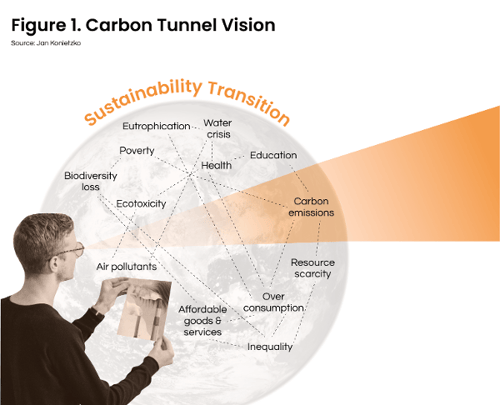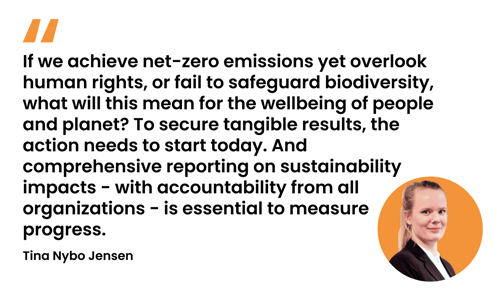The Carbon Tunnel Vision Trap
-1.png)
What is carbon tunnel vision?
When talking about climate change, the odds are your brain starts visualising aeroplanes, smoggy chimneys and polluting exhaust pipes. And by visualising this, your brain is directly linking climate change to greenhouse gas emissions. This is true.
However, it’s not the complete picture. You are trapped in what is called Carbon Tunnel Vision. Dr Jan Konietzko from COGNIZANT first coined the term. This means that you are only thinking about carbon emissions when it comes to climate change.
Is that bad? Not entirely. But it does cause you and your organisation might miss out on other aspects that should be tackled in fighting climate change and that make up the wider concept of sustainability. Read on to find out where the biggest carbon tunnel vision is, how to tackle it and which other priorities you can set for your organisation.

What is wrong with having carbon tunnel vision?
Climate change is affecting the liveability of our planet. To summarise what needs to be done to keep our planet liveable for humans, the planetary boundaries were introduced. This concept describes thresholds within which humanity can survive, develop and thrive for generations to come. In total, there are nine Planetary Boundaries that regulate the stability and resilience of our planet.
Only one of the boundaries addresses the climate crisis. The other boundaries, e.g. diversity loss, ozone depletion and biodiversity loss, should also be taken into account when aiming for a healthy planet. Putting climate change and carbon emissions at the very top of the agenda means ignoring the other eight. This is something we cannot afford to do.
Besides, there is a strong level of interconnection between the boundaries and putting only the one related to climate change at the centre will jeopardise Earth’s health.
For example, let’s look at ‘deforestation and other land-use changes. Soil acts as an important natural carbon sink when in its original state. According to the World Resource Institute, it could yearly store about 5% of human-made GHG emissions produced in one year.
Unfortunately, due to deforestation, unsustainable agricultural practices, pesticides, and other chemicals, 20 to 40% of global land is currently degraded. As a result, the carbon sink effects diminish tremendously.
At this point you might think:
Yes, but a lot of trees are planted with the help of carbon offsets, right?
Indeed, a lot is communicated about the growing market of carbon offsets and the planting of trees, which gives the impression we are heading in the right direction. We are not.
We are tackling climate change by buying carbon offsets and planting new trees. Yet we are losing forests at a rate comparable to twenty-seven soccer fields per minute. Not to mention that young forests do not have the same CO2 storing capabilities as older ones.
By destroying these soil ecosystems, we are turning forests from carbon sinks into carbon sources. And that is not all, deforestation and land-use change are also affecting other planetary boundaries. For example, both deforestation and land degradation affect the soil, which in turn affects the habitat of many organisms, causing biodiversity loss. (We recently published an article on the biodiversity crisis if you want to learn more).
Carbon tunnel vision also means losing sight of the inner boundaries of the Doughnut Economics model. Social tipping points should be included in corporate sustainability strategies.

What other factors should your organisation consider?
Short answer? All other factors. But, the list of sustainability issues is long. To make this actionable and oriented towards organisations, we can turn to double materiality.
A materiality assessment will help your organisation navigate the long list of potential factors to consider.
This step involves engaging stakeholders in the process, which will account for more than only CO2e emissions.
To be fair, a likely outcome is that stakeholders will focus on transparency around the carbon footprint. However, it will also bring to light other factors within your organisation’s ESG strategy.
The relevant topics identified through the materiality analysis should all be tracked through proper KPIs.
In fact, besides your GHG emissions, you can measure a variety of other environmental and social impacts, such as:
Environmental KPIs:
- Total energy consumption
- Tonnes of generated waste
- Litres of used water
Other sustainability KPIs:
- Percentage of suppliers that have signed a supplier Code of Conduct
- Gender ratio across different organisational levels and on the board
- Gender pay gap
- Hours of training per employee offered during the year
- Whistle-blower procedure in place
How to avoid carbon tunnel vision?
1. Be aware of all relevant impact factors.
For product companies, Life Cycle Assessments can help assess the environmental impact of the products in your portfolio by mapping their impacts from sourcing of raw materials to final disposal.
In the social sphere, a Social Life Cycle Assessment will guide your efforts. It addresses topics such as human rights, working conditions, etc.
These types of assessments will create more awareness around the total impact of your organisation. Moreover, they will force you to look beyond your organisation’s boundaries by including suppliers and end consumers.
They will help create a better understanding of what sustainability means to your organisation. Of course, it’s important to then act on this knowledge and share it at all levels of your organisation and collaborate.
2. Break down silos within your organisation
Achieving sustainable change and development largely hinges on collaboration. It’s by sharing information and data with other departments that you’ll be able to build a wide knowledge of the impacts generated by your business activities. By embedding sustainability into your organisation and creating ownership in all departments, you will be able to maximise the positive and minimise the negative impacts
3. Bring the broader sustainability agenda into your strategy
Align with standards and frameworks to underpin your action. The GRI Standards broadly address the economy, society as well as the environment. The 17 SDGs aim to address all aspects of the sustainability agenda.
4. Enhance global collaboration
To combat climate change, global action is needed. Meaningful change will likely come in the form of collaboration, both within the private sector as well as between the public and private sectors.
5. Improve data availability beyond GHG emissions
There is currently a data gap when it comes to biodiversity and natural depletion.
Data collection, monitoring and management are key players as “if you can’t measure it you can’t improve it” (thank you, - Peter Drucker).
Therefore, the following are key questions to address:
- What data do you need?
- Where do you get the data from?
- What are the data requirements?
- Where do you report the data?
- How, when and where is the data used?
Effective data management allows it to become actionable, and to track progress over time. This above-mentioned system should contain data points relating to environmental, social and economic impacts (ESG data) that stretch beyond carbon emissions.
Conclusion
The main concern is that by only focusing on emission reduction, other significant issues are not being paid attention to as they should. Education and knowledge building for one. Putting policies and procedures in place, the list goes on.
Taking a holistic approach to sustainability is the solution and also what is needed at scale. With the right ESG strategy, organisations step into the position to take meaningful action.
By simultaneously working on multiple sustainability issues, you can benefit from a multiplier effect because of the strong relationship between environmental, social and governance.
Finally, we should abandon the short-term mindset for a more forward-looking one.